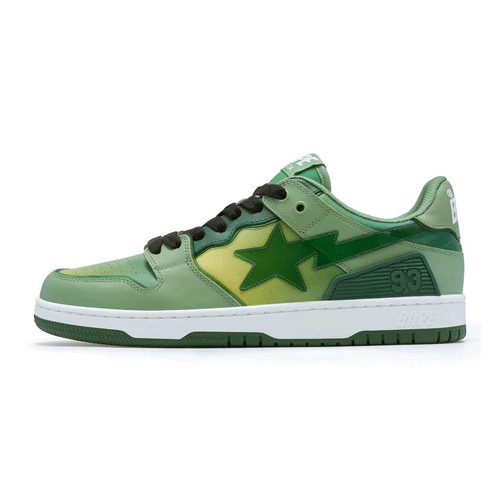
In the realm of sneakers and streetwear, few names evoke as much energy and nostalgia as Bapesta. Created by the legendary Japanese brand A Bathing Ape (BAPE), the Bapesta is more than just a sneaker—it’s a symbol of rebellion, creativity, and the global rise of urban fashion. From hip-hop moguls to streetwear collectors, the Bapesta has found its way onto the feet and into the hearts of countless enthusiasts around the world.
The Birth of Bapesta: A Tribute to Sneaker Culture
The Bapesta was first introduced in the early 2000s by Nigo, the founder of BAPE. The design immediately stood out due to its unmistakable resemblance to Nike’s Air Force 1. From its chunky midsole to the low-cut silhouette and perforated toe box, the similarities were not subtle—but they were intentional.
Nigo, a devoted sneakerhead and pop culture connoisseur, saw the Air Force 1 as a blank canvas. What he added was the unmistakable BAPE flavor—bright patent leather colorways, the lightning bolt “STA” logo, and over-the-top branding that screamed individuality. In a time when Japanese streetwear was emerging onto the global stage, the Bapesta was BAPE’s declaration of artistic freedom and cultural remixing.
A Design That Sparked Debate
When the Bapesta first hit the streets, it immediately sparked controversy. Critics labeled it a “knockoff,” while fans argued it was a reimagined homage. Over time, the latter viewpoint prevailed. Bapesta’s design wasn’t about replication—it was about recontextualization. By taking a Western silhouette and injecting it with Japanese flair, Nigo was not copying but curating a new identity for streetwear.
The Bapesta’s materials also played a pivotal role in its aesthetic. Glossy patent leather, vibrant two-tone color blocking, and camo patterns were a stark contrast to the more muted styles dominating sneaker shelves at the time. It turned heads—and that was the point.
Collaborations That Elevated the Game
One of the reasons Bapesta achieved cult status was its legendary lineup of collaborations. Early partnerships with global icons like Kanye West, Pharrell Williams. SpongeBob SquarePants helped cement the Bapesta as a cultural phenomenon.
The Kanye West “Dropout Bear” Bapestas, featuring the cartoon bear mascot from The College Dropout, are still among the most sought-after pairs. Similarly, the collaboration with Pharrell’s Billionaire Boys Club—another Nigo-led project—pushed the fusion of music, art, and fashion even further.
These collaborations weren’t just about celebrity endorsements. They were mutual celebrations of creativity, bridging streetwear, music, and visual art into one coherent lifestyle brand. Each limited-edition release carried both exclusivity and story, creating a deep emotional connection between the product and its audience.
Bapesta’s Role in the Sneaker Resale Boom
The 2000s marked a turning point for sneaker culture, particularly with the rise of resale marketplaces and online hype communities. Bapesta, with its limited drops and wild designs, naturally became a hot commodity.
Collectors would queue for hours—or even days—to get their hands on the newest colorway. Online forums buzzed with photos and price speculation. Some of the rarer models now command prices in the thousands on platforms like StockX and GOAT.
This resale frenzy only amplified the brand’s mystique. Owning a pair of Bapestas wasn’t just about style—it was about status. In the same way Supreme fueled scarcity-driven demand in streetwear, Bapesta became a symbol of exclusivity in sneaker culture.
The Bapesta Comeback: A New Era
While BAPE’s influence saw a slight dip during the mid-2010s due to changing fashion trends and competition. The brand—and the Bapesta—has made a strong comeback in recent years. New collaborations with artists like Kid Cudi, J. Cole, and ASAP Rocky have revived mainstream interest, especially among Gen Z.
The new Bapesta designs now include high-end materials, sleeker silhouettes, and collaborations that embrace the digital era. NFT integrations, AR-powered try-ons, and exclusive online drops show that BAPE isn’t stuck in the past—it’s pushing the envelope once again.
Meanwhile, vintage Bapestas from the early 2000s are enjoying renewed attention on social media, especially platforms like TikTok and Instagram. The Y2K aesthetic, combined with the sneaker’s bold colors, fits perfectly into today’s fashion landscape.
Why the Bapesta Still Matters
In an industry saturated with new drops every week, the fact that Bapesta continues to spark conversation is a testament to its enduring appeal. It matters because it represents the intersection of global culture, individual expression, and fearless design.
It was one of the first sneakers to truly embrace streetwear as high fashion—long before major luxury houses started copying the playbook. It dared to remix American icons through a Japanese lens. And it did all of this without ever trying to fit in.
For those who wear Bapesta, it’s not just a sneaker—it’s a statement.
Styling the Bapesta: Then and Now
Back in the 2000s, Bapestas were paired with baggy jeans, oversized hoodies, and flashy chains—a look heavily inspired by hip-hop and urban style. Today,they’re being styled in more varied ways, from minimal streetwear fits with cargo pants and cropped jackets to avant-garde ensembles on fashion runways.
The sneaker’s loud design makes it a perfect centerpiece. Whether you’re dressing up for a fashion show or keeping it casual, Bapestas offer the kind of versatility that lets your personality shine through.
Final Thoughts: The Legacy of the Bapesta
The Bapesta is more than a sneaker—it’s a cultural artifact. Its journey from a niche Japanese release to an international fashion staple reflects the power of streetwear as a movement. With every reissue and new collaboration, the Bapesta reminds us why fashion should be fun, fearless, and unapologetically expressive.





